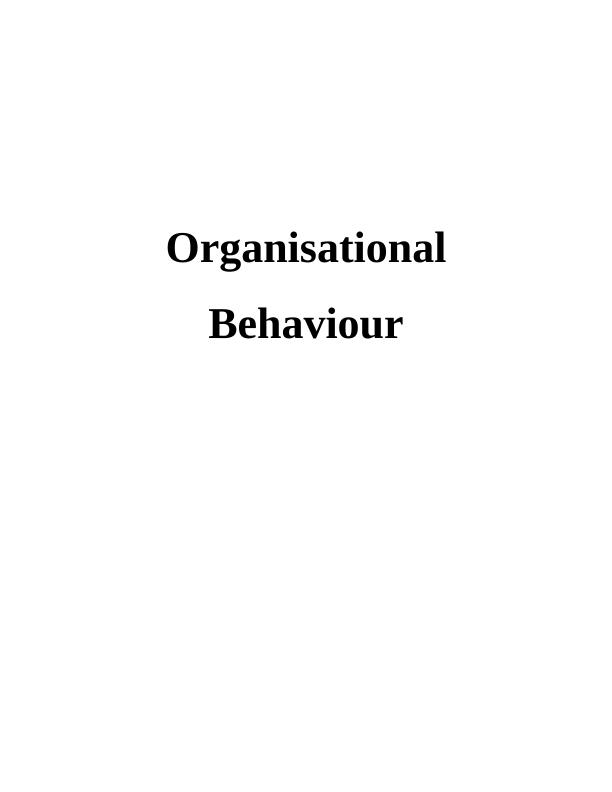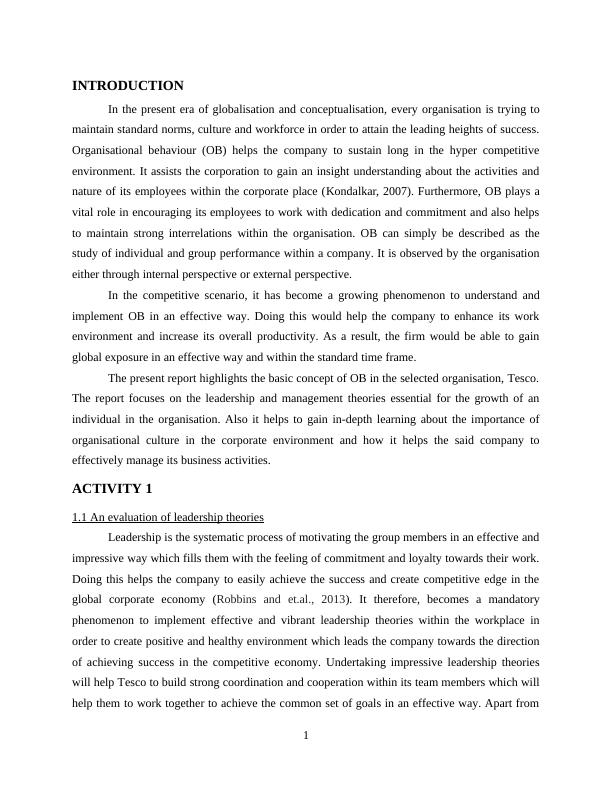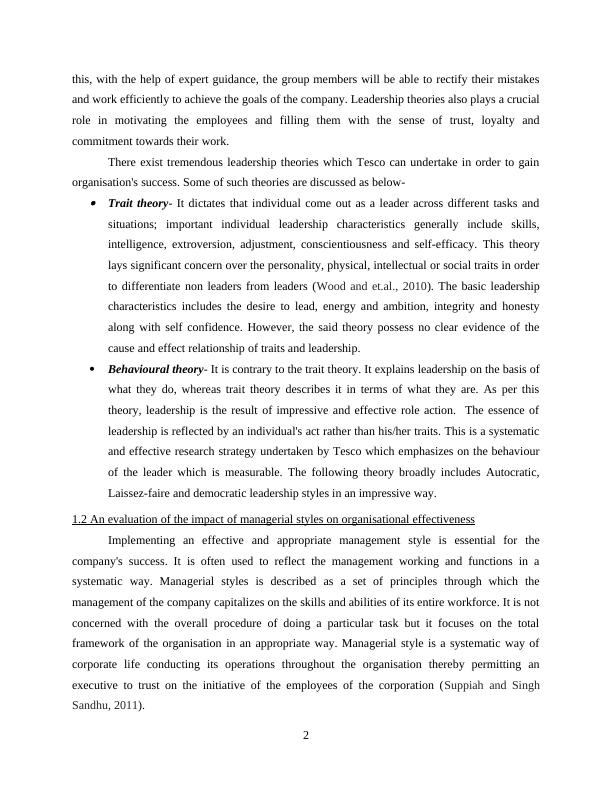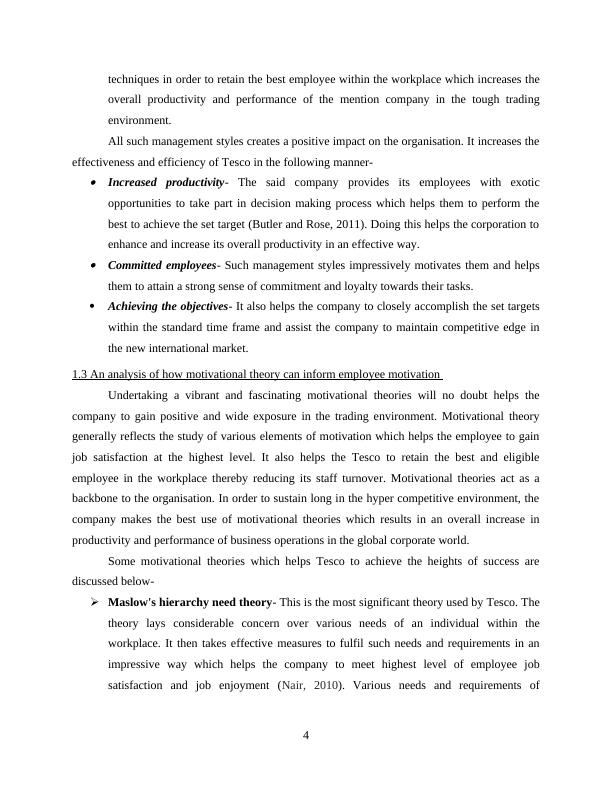Leadership and Management Theories | Report
Added on 2020-01-28
21 Pages6424 Words228 Views
OrganisationalBehaviour

Table of ContentsINTRODUCTION...........................................................................................................................1ACTIVITY 1....................................................................................................................................11.1 An evaluation of leadership theories.....................................................................................11.2 An evaluation of the impact of managerial styles on organisational effectiveness..............21.3 An analysis of how motivational theory can inform employee motivation .........................41.4 An analysis of theories relating to work relationships and interaction.................................7ACTIVITY 2....................................................................................................................................92.1 & 2.2 Covered in ppt............................................................................................................93.1Analysing how organisation facilitating innovation and Creativity......................................93.2 Importance of learning in an organisation.........................................................................103.3 Evaluating Effectiveness of Team.....................................................................................103.4 An analysis of the effectiveness of change........................................................................11ACTIVITY 3..................................................................................................................................122.3 An analysis of the culture and structure of Tesco and its impact on the organisation'seffectiveness..............................................................................................................................12ACTIVITY 4..................................................................................................................................144.1 An analysis of different approaches to organisational decision making.............................144.2 An assessment of management approaches to risk and uncertainty in decision making....154.3 An evaluation of the effectiveness of organisational decisions in Tesco............................15CONCLUSION..............................................................................................................................16REFERENCES..............................................................................................................................17

INTRODUCTIONIn the present era of globalisation and conceptualisation, every organisation is trying tomaintain standard norms, culture and workforce in order to attain the leading heights of success.Organisational behaviour (OB) helps the company to sustain long in the hyper competitiveenvironment. It assists the corporation to gain an insight understanding about the activities andnature of its employees within the corporate place (Kondalkar, 2007). Furthermore, OB plays avital role in encouraging its employees to work with dedication and commitment and also helpsto maintain strong interrelations within the organisation. OB can simply be described as thestudy of individual and group performance within a company. It is observed by the organisationeither through internal perspective or external perspective. In the competitive scenario, it has become a growing phenomenon to understand andimplement OB in an effective way. Doing this would help the company to enhance its workenvironment and increase its overall productivity. As a result, the firm would be able to gainglobal exposure in an effective way and within the standard time frame. The present report highlights the basic concept of OB in the selected organisation, Tesco.The report focuses on the leadership and management theories essential for the growth of anindividual in the organisation. Also it helps to gain in-depth learning about the importance oforganisational culture in the corporate environment and how it helps the said company toeffectively manage its business activities. ACTIVITY 11.1 An evaluation of leadership theoriesLeadership is the systematic process of motivating the group members in an effective andimpressive way which fills them with the feeling of commitment and loyalty towards their work.Doing this helps the company to easily achieve the success and create competitive edge in theglobal corporate economy (Robbins and et.al., 2013). It therefore, becomes a mandatoryphenomenon to implement effective and vibrant leadership theories within the workplace inorder to create positive and healthy environment which leads the company towards the directionof achieving success in the competitive economy. Undertaking impressive leadership theorieswill help Tesco to build strong coordination and cooperation within its team members which willhelp them to work together to achieve the common set of goals in an effective way. Apart from1

this, with the help of expert guidance, the group members will be able to rectify their mistakesand work efficiently to achieve the goals of the company. Leadership theories also plays a crucialrole in motivating the employees and filling them with the sense of trust, loyalty andcommitment towards their work.There exist tremendous leadership theories which Tesco can undertake in order to gainorganisation's success. Some of such theories are discussed as below-Trait theory- It dictates that individual come out as a leader across different tasks andsituations; important individual leadership characteristics generally include skills,intelligence, extroversion, adjustment, conscientiousness and self-efficacy. This theorylays significant concern over the personality, physical, intellectual or social traits in orderto differentiate non leaders from leaders (Wood and et.al., 2010). The basic leadershipcharacteristics includes the desire to lead, energy and ambition, integrity and honestyalong with self confidence. However, the said theory possess no clear evidence of thecause and effect relationship of traits and leadership.Behavioural theory- It is contrary to the trait theory. It explains leadership on the basis ofwhat they do, whereas trait theory describes it in terms of what they are. As per thistheory, leadership is the result of impressive and effective role action. The essence ofleadership is reflected by an individual's act rather than his/her traits. This is a systematicand effective research strategy undertaken by Tesco which emphasizes on the behaviourof the leader which is measurable. The following theory broadly includes Autocratic,Laissez-faire and democratic leadership styles in an impressive way. 1.2 An evaluation of the impact of managerial styles on organisational effectivenessImplementing an effective and appropriate management style is essential for thecompany's success. It is often used to reflect the management working and functions in asystematic way. Managerial styles is described as a set of principles through which themanagement of the company capitalizes on the skills and abilities of its entire workforce. It is notconcerned with the overall procedure of doing a particular task but it focuses on the totalframework of the organisation in an appropriate way. Managerial style is a systematic way ofcorporate life conducting its operations throughout the organisation thereby permitting anexecutive to trust on the initiative of the employees of the corporation (Suppiah and SinghSandhu, 2011). 2

Effective and exotic management style reflects the scope to which a leader progressivelyand continually directs and leads the employees towards the set destination. It is a systematicapproach of accomplishing the heights of success by transforming the available resources intohigh quality and best outcome through the effective managerial functions of Tesco. The saidcompany considers management style as one the most distinctive approach of making relevantdecisions, formulating and implementing strategic vision and setting goal to beat its line ofcompetitors in the fast changing environment. There are several types of managerial styles undertaken by the managers of Tesco in animpressive and effective way. Some essential styles are explained below-Authoritarian management style- Under such kind of management style, the leaderformulates certain policies and norms and implements it within the workplace withoutinvolving the subordinates and employees in the decision making scenario of theorganisation. This style is implemented by Tesco when it is facing various challenges inthe corporate world and does not get sufficient time to involve employees in the decisionmaking process of the company. Under such a situation, the management of the companyonly give commands to its sub ordinates to get the task done on the given time frame.This style creates negative impact on the mind of employees and forces them to quit thejob as they are least interested in doing the job with so much burden. However, this stylebrings positive results for the company which helps it to attain global exposure in thehyper competitive environment (Inesi and et.al., 2011). Democratic/ Participative management style- According to this managerial style, thesaid company undertakes the core involvement of employees in the decision making andproblem solving process of the organisation. Doing this benefits the organisation to createa strong sense of trust, loyalty and commitment within employees towards their work.This helps Tesco to attain the highest level of employee job satisfaction and also allowsto minimize its overall employee turnover. Permissive management style- The said style lays its significant concern over theemployees and make use of their decisions which helps Tesco to bring innovations andquality productions in a fascinating way. The subordinates and employees are get valuedand the management of the company treat them as core asset for the business rather thancost. This management style focuses on implementing effective employee engagement3

techniques in order to retain the best employee within the workplace which increases theoverall productivity and performance of the mention company in the tough tradingenvironment.All such management styles creates a positive impact on the organisation. It increases theeffectiveness and efficiency of Tesco in the following manner-Increased productivity- The said company provides its employees with exoticopportunities to take part in decision making process which helps them to perform thebest to achieve the set target (Butler and Rose, 2011). Doing this helps the corporation toenhance and increase its overall productivity in an effective way.Committed employees- Such management styles impressively motivates them and helpsthem to attain a strong sense of commitment and loyalty towards their tasks.Achieving the objectives- It also helps the company to closely accomplish the set targetswithin the standard time frame and assist the company to maintain competitive edge inthe new international market.1.3 An analysis of how motivational theory can inform employee motivation Undertaking a vibrant and fascinating motivational theories will no doubt helps thecompany to gain positive and wide exposure in the trading environment. Motivational theorygenerally reflects the study of various elements of motivation which helps the employee to gainjob satisfaction at the highest level. It also helps the Tesco to retain the best and eligibleemployee in the workplace thereby reducing its staff turnover. Motivational theories act as abackbone to the organisation. In order to sustain long in the hyper competitive environment, thecompany makes the best use of motivational theories which results in an overall increase inproductivity and performance of business operations in the global corporate world. Some motivational theories which helps Tesco to achieve the heights of success arediscussed below-Maslow's hierarchy need theory- This is the most significant theory used by Tesco. Thetheory lays considerable concern over various needs of an individual within theworkplace. It then takes effective measures to fulfil such needs and requirements in animpressive way which helps the company to meet highest level of employee jobsatisfaction and job enjoyment (Nair, 2010). Various needs and requirements of4

End of preview
Want to access all the pages? Upload your documents or become a member.
Related Documents
Leadership Styles and Motivation in Toyota Motor : Reportlg...
|14
|3943
|2529
Organisational Behaviour in TESCO : Doclg...
|13
|3473
|20
Project on Organisational Behaviour of BBClg...
|13
|4273
|44
Leadership and Management Theories in Google : Reportlg...
|16
|4394
|151
Organization Behaviour Assignment : Morrisonlg...
|14
|4459
|49
Organisational Behaviourlg...
|18
|6423
|475